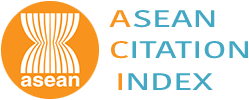Correlation between Body Mass Index, Gender, and Skeletal Muscle Mass Cut off Point in Bandung
Abstract
Objective: To determine the average skeletal muscle mass (SMM) value in young adults as a reference population; to analyze the correlation of gender, and body mass index to the cut off point; and to determine skeletal muscle mass cut off points of population in Bandung, Indonesia.
Methods: This was a cross-sectional study involving 199 participants, 122 females and 77 males. The sampling technique used was the multistage random sampling. The participants were those who lived in four major regions in Bandung, Indonesia: Sukajadi, Cicadas, Buah Batu, and Cibaduyut.
Results: The average appendicular skeletal mass index (ASMI) in females and males based on body mass index (BMI) were identified. The average ASMI values for normal BMI in females was 5.982±0.462 kg/m2 while the average ASMI values normal BMI for males was 7.581±0.744 kg/m2
Conclusions: A correlation between BMI and ASMI that was considered statistically significant was found in females (0.7712; p<0.05) and a very significant correlation was seen in males (0.870; p<0.05). The cut off points were defined by the normal BMI, which were 5.059 for females and 6.093 for males.
Keywords: Appendicular skeletal muscle mass index, body mass index, cut off point, gender, skeletal muscle mass
DOI: 10.15850/ijihs.v5n2.990
Keywords
Full Text:
PDFReferences
Sakuma K, Aoi W, Yamaguchi A. The intriguing regulators of muscle mass in sarcopenia and muscular dystrophy. Front Aging Neurosci. 2014;6(1):1–17.
Stenholm S, Harris TB, Rantanen T, Visser M, Kritchevsky SB, Ferrucci L. Sarcopenic obesity: definition, cause and consequences. Curr Opin Clin Nutr Metab Care. 2008;11(6):693–700.
Chen LK, Liu LK, Woo J, Assantachai P, Auyeung TW, Bahyah KS, et al. Sarcopenia in Asia: consensus report of the Asian Working Group for Sarcopenia. J Am Med Dir Assoc. 2014;15(2):95–101.
Cruz-Jentoft AJ, Baeyens JP, Bauer JM, Boirie Y, Cederholm T, Landi F, et al. Sarcopenia: European consensus on definition and diagnosis. 2010;39(4):412–23.
Yamada Y, Watanabe Y, Ikenaga M, Yokoyama K, Yoshida T, Morimoto T, et al. Comparison of single- or multifrequency bioelectrical impedance analysis and spectroscopy for assessment of appendicular skeletal muscle in the elderly. J Appl Physiol. 2013;115(6):812–8.
Chien MY, Huang TY, Wu YT. Prevalence of sarcopenia estimated using a bioelectrical impedance analysis prediction equation in community-dwelling elderly people in Taiwan. J Am Geriatr Soc. 2008;56(9):1710–5.
Alemán-Mateo H, Valenzuela RER. Skeletal muscle mass indices in healthy young Mexican adults aged 20–40 years: implications for diagnoses of sarcopenia in the elderly population. Sci World J [serial on the internet]. 2014 [cited 2016 June 20];2014(1):[about 5p.]. Available from: http://www.hindawi.com/journals/tswj/2014/672158/.
Krzymińska-Siemaszko R, Czepulis N, Suwalska A, Dworak LB, Fryzowicz A, Madej-Dziechciarow B, et al. The significance of body mass index in calculating the cut-off points for low muscle mass in the elderly: methodological issues. Bio Med Res Int. [serial on the internet]. 2014 [cited 2016 June 20];2014(1):[about 8p.]. Available from: http://www.hindawi.com/journals/bmri/2014/450396/.
Wen X, Wang M, Jiang CM, Zhang YM. Are current definitions of sarcopenia applicable for older Chinese adults? J Nutr Health Aging. 2011;15(10):847–51.
Baumgartner RN, Koehler KM, Gallagher D, Romero L, Heymsfield SB, Ross RR, et al. Epidemiology of sarcopenia among the elderly in New Mexico. Am J Epidemiol. 1998;147(8):755–63.
Kim TN, Yang SJ, Yoo HJ, Lim KI, Kang HJ, Song W, et al. Prevalence of sarcopenia and sarcopenic obesity in Korean adults: the Korean sarcopenic obesity study. Int J Obes (Lond). 2009;33(8):885–92.
Woods JL, Iuliano-Burns S, King SJ, Strauss BJ, Walker KZ. Poor physical function in elderly women in low-level aged care is related to muscle strength rather than to measures of sarcopenia. Clin Interv Aging. 2011;6(1):67–76.
Mukaka MM. Statistics corner: a guide to appropriate use of correlation coefficient in medical research. Malawi Med J. 2012;24(3):69–71.
Malafarina V, Uriz-Otano F, Iniesta R, Gil-Guerrero L. Sarcopenia in the elderly: diagnosis, physiopathology and treatment. Maturitas. 2012;71(2):109–14.
Kalyani RR, Corriere M, Ferrucci L. Age-related and disease-related muscle loss: the effect of diabetes, obesity, and other diseases. Lancet Diabetes Endocrinol. 2014;2(10):819–29.
Ranasinghe C, Gamage P, Katulanda P, Andraweera N, Thilakarathne S, Tharanga P. Relationship between body mass index (BMI) and body fat percentage, estimated by bioelectrical impedance, in a group of Sri Lankan adults: a cross sectional study. BMC Public Health. [serial on the internet]. 2013 [cited 2016 June 25];13(797):[about 8p.]. Available from: https://bmcpublichealth.biomedcentral.com/articles/10.1186/1471-2458-13-797.
Deurenberg P, Deurenberg Yap M, Wang J, Lin FP, Schmidt G. The impact of body build on the relationship between body mass index and percent body fat. Int J Obes Metab Disord. 1999;23(5):537–42.
Gurrici S, Hartriyanti Y, Hautvast JG, Deurenberg P. Differences in the relationship between body fat and body mass index between two different Indonesian ethnic groups: the effect of body build. Eur J Clin Nutr. 1999;53(6):468–72.
Tanimoto Y, Watanabe M, Sun W, Hirota C, Sugiura Y, Kono R, et al. Association between muscle mass and disability in performing instrumental activities of daily living (IADL) in community-dwelling elderly in Japan. Arch Gerontol Geriatr. 2012;54(2):230–3.
Kesehatan BPdP. RISKESDAS 2013. Jakarta: Kementrian Kesehatan RI; 2013.
Article Metrics
Abstract view : 3081 timesPDF - 736 times
This Journal indexed by

IJIHS is licensed under a Creative Commons Attribution-NonCommercial 4.0 International License
View My Stats




